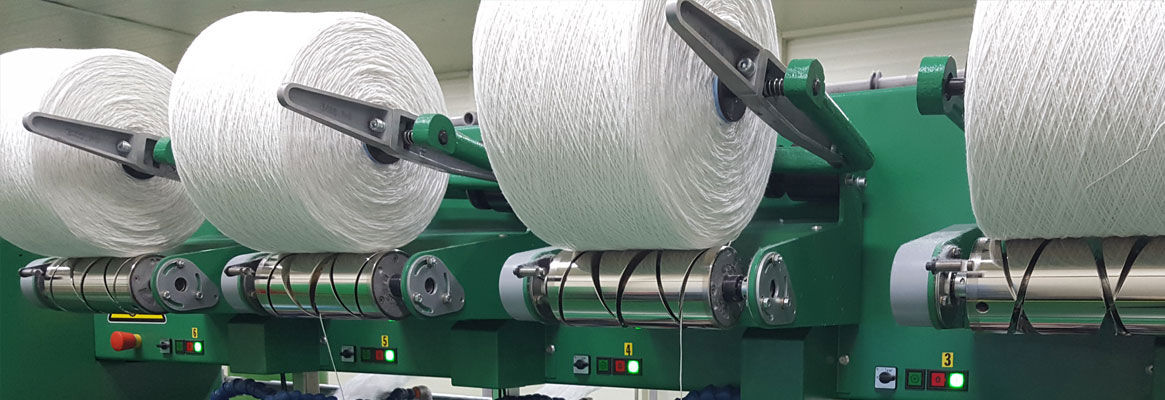*Ahmedabad Textile Industry’s ResearchAssociation, Ahmedabad (ATIRA),
**M/s. Zenith Fibers Ltd., Vadodara
Abstract:
Polypropylene Staple Fiber (PPSF) is fast out pacing other synthetic fibers in terms of market growth and is finding new and varied enduses over old and traditional synthetic fibers. It is now being used in themanufacture of Drinking Water Filter Cartridges. ATIRA is producing the special type of technical textile, the PP yarn needed for this, using DREF Technology. In this paper, a case study, where the specifications of the PPSF fibersand the DREF yarns and their performance in drinking water filter cartridgeshas been given, will be discussed in detail.
Filter yarns spun on DREF 2 machines have captured a leading position in the filter cartridge market. The annual worldwide requirement of such filter elements is in the region of several million units. The body of the filter consists of a perforated cylindrical support, which is wrapped by means of precision winding with a highly voluminous yarn (800-1500 tex). The thickness of this covering dictates the micron value of the filter, e.g., 0.5-200 micron. These filter elements are available mainly in the popular 250, 500, 750, and 1000 mm lengths.
DREF Spinning
Fehrer DREF 2 friction spinning is a versatile technology. It can be used for manufacturing everything from asbestos substitutes and secondary carpet backing yarns, to technical products such as cartridges for liquid filtration.2
Fig 1: Fehrer DREF-2 Spinning Machine3
This technology belongs to the open endgroup because the fiber strand (sliver) must be opened completely to individualizefibers and re-assembled to form a new strand (yarn). In DREF 2 spinning one ortwo carded slivers after leaving from the drafting arrangement are passed tothe main saw toothed opening roller. While the drafting arrangement createsonly a light drafting effect, the saw tooth roller opens the strand toindividual fibers. The separated fibers are lifted off the roller by a blowerand form cloud, descending towards two perforated drums. One suction stream perdrum draws the fibers into the convergent region. The newly arriving fiberscontact the rotating yarn and are thereby caught and twisted. This process is primarily suited for the production of coarser yarns and recycled yarns.
The applications of DREF spun yarns are:
Blankets for the hometex range and military uses, as well as for hotels, hospitals, camping plaids etc.; Secondary carpet backing for tufted carpets and filler yarns for carpet wefts; Filter cartridges for liquid filtration; Canvas for the military and civil sectors -Asbestos substitutes (e.g. heavy protective clothing and gloves, gaskets, packings, clutch- and brake linings, flame retardant fabrics etc.); Filler yarns for the cable, packaging, shoe and carpet industries; High-tenacity, core yarns for ropes, transport and conveyor belts; High tenacity fire resistant protective clothing ; Composites for the aviation, automotive and engineering industries etc.1
At present, around 80 DREF 2 machines are
spinning 30,000 t of yarns for liquid filtration. The main markets are Europe
and the USA, where some 150 million filter cartridges are manufactured with
DREF 2 yarns, a figure that represents 65-70% of global production. The leading
US and European filter producers spin a wide range of DREF 2 PP-yarns at speeds
of 160 - 180 m/min. A specialist manufacturer employs DREF products for over 20 types of cartridges that require compatibility with FDA foodstuffs
legislation. The yarns employed generally consist of PP fibers in the 3.3 dtex,
40 mm range, which are highly resistant to micro-organisms and have a wide
scope of chemical applications.2 As per information available with
us the demand of the DREF 2 PP yarns in India is about 800 tons per annum only
for filter cartridges and it is likely to increase considerably in next one or
two years.
The fiber material of the yarns used is primarily selected with a view to the chemical properties and the temperature of the filtered
substance. Manmade fibers account for the majority of applications, with cotton
being prescribed mainly for environments where higher temperatures prevail.
Fig 2: DREF -2 Yarn Package and Wound
Filter cartridges 4
PPSF has
following unique properties:
1. Lowest specific
gravity of 0.91 (provides excellent covering).
2. Negligible Moisture absorption (0.05).
3. Provides very warm feel (warmer than wool and acrylic).
4. Fabric containing PPSF wicks away moisture from skin to atmosphere due
to the capillary action.
5. PPSF is resistant to many acids, alkalis and solvents.
6. PPSF is resistant to attack of mildew/moths/insects and a wide range
of bacteria.
7. Not prone to static charge generation.
8. PPSF is dope- dyed in various shades/colours and there will not be any
variation between fiber lots of the same shade.
9. Not subject to light degradation, if UV Stabilized.
10. Highly resilient fiber.
11. PPSF is available in round cross-section and also in Trilobal shape (for
superior sparkle/luster.)6
The details of the PP fibers
used for the manufacture of the yarn for the filter cartridge at ATIRA and the
quality parameters are given in the tables 1 to 3.
The most important characteristic of the
filter element is its permeability expressed in µm. This indicates the minimum
particle size (i.e. particle diameter) which will be eliminated to a minimum
degree of 90%. Yarn package filter elements are used for separating particle sizes
in the range of 0.5 to100 µm.
Lowest possible price and high durability
are the most important economic criteria. Moreover, lowest possible resistance
to throughput (Δp) is desirable for every grade of permeability. Given the
same type of yarn, permeability of the corresponding filter element directly
correlates with the value of Δp. A higher Δp value means a lower µm
grading of the filter element.
The permeability of a yarn package filter
element is in particular determined by the following parameters:
-winding conditions (yarn path geometry,
thickness of yarn layer, yarn tension during winding)
-yarn parameters (yarn structure or
spinning process, yarn twist factor, yarn count or rather yarn diameter, yarn
uniformity)
-Fiber material (in particular fiber
fineness or rather fiber diameter)
Given that all other parameters remain constant,
finer fibers will increase the Δp values and at the same time, result in
lower permeability. At the same time, filter elements of same permeability will
feature lower resistance to throughput, i.e. lower Δp values if finer fibers
are used instead of coarser ones.
The influence of yarn twist factor on the
resistance to throughput of filter elements is in the case of roving yarn. The
lower the yarn twist factor, the higher the value, because the cavities between
individual yarn strands are closer due to facilitated lateral compressibility of the yarn.
The value often increases with the
increase in yarn diameter in the range of yarn counts 800 to1500 tex.8
Advantages of Friction-spun yarns over Flyer
yarns (Rovings) for filter cartridges:
-Better
yarn regularity combined with high resistance.
-Greater
bulkiness of the yarn (20-40% more air volume) for better winding. Density compared to conventional filter
cartridges.
-Roving
has to be highly twisted for winding into cones and this is not the case with
Dref-2 yarn. With the result the porosity of roving gets adversely affectedLess
flow resistance than flyer yarns specially in tight packages
-Improved dirt particle retention and up to twice the filter service life
-The
fiber structures are relatively random and subject to high degree of twist. The
yarns offer great regularity and increased strength.
-The
round yarn cross-section ensures limited deformation under transverse load.
-Considerable
reduced yarn production costs (up to 50%) due to lower yarn mass requirement, lower
preparation costs, lower spinning costs (as a result of higher output 15 to 20
times higher than with conventional production processes and high efficiency as
well as bobbin weights up to 10 Kg.) and lower personnel expenses.
-Knot-free,
uniform quality of the yarns guarantees faultless filters up to a filter length
of 200 cm.
-Constant
micron value in the filter due to regular yarn quality
-Because
of the layer construction of the yarn, its surface is twisted very loosely providing the hairiness necessary for good filtration (higher flow rate with the same filtration
effect).
-The
universal use of all the fibers preferably processed for filters such as F.D.A.
(Food and Drug Administration) bleached cotton, natural cotton, polypropylene, PP (F.D.A.), polyester, acrylic, modacrylic, polyamide and other special fibres.7
The process of manufacturing the PP DREF
2 yarn upto drawframe is similar to that of normal synthetic fibers and no
additional spin finish is required to be used Efficiency of
80-90% is achievable at 180 m/min speed in DREF 2 machine. The waste level is
1-1.5% which is very negligible and is recyclable. One of the main problems related to practical working is that of fiber melting which leads to end breakage,
lapping on combing roller and damage to the combing roller. This calls for
optimization of combing roller speed and material feeding speed.
So, it is very easy to convert PPSF into
yarn by DREF 2 technology and the yarn is most suitable for filter cartridges
which have a very good market potential in India and abroad. The usefulness of PP
fiber in the manufacturing of technical yams has been also highlighted through
this presentation and many such uses can be found for the fiber. There is a
need to study the available technologies and find the appropriate one for the particular end-uses.
References:
- New trends in machinery development for technical textiles - I-Express Textile-Nov,2005 (www.expresstextile.com)
- http://www.fehrerag.com/fehrer/Artic08.htm
- www.wotol.com/machinery/fehrer-dref-2-ft-p13237/photo-1167129446945.jsp
- http://www.chinafrictionmaterial.com/eproduct-pp.htm
- http://www.pall.com/terms_38029.asp
- www.zenithfibres.com
- Manfred Gsteu, Tritz oberlehner-“DREF-Friction-spun yarns for filter cartridges”
- Mellind English, December 1990, pp.944-946
To read more articles on Textile, Industry, Technical Textile, Dyes & Chemicals, Machinery, Fashion, Apparel, Technology, Retail, Leather, Footwear & Jewellery, Software and General please visit http://articles.fibre2fashion.com
To promote your company, product and services via promotional article, follow this link: http://www.fibre2fashion.com/services/article-writing-service/content-promotion-services.asp








